Unti 6 How many? PC Story time 教案
文档属性
| 名称 | Unti 6 How many? PC Story time 教案 | 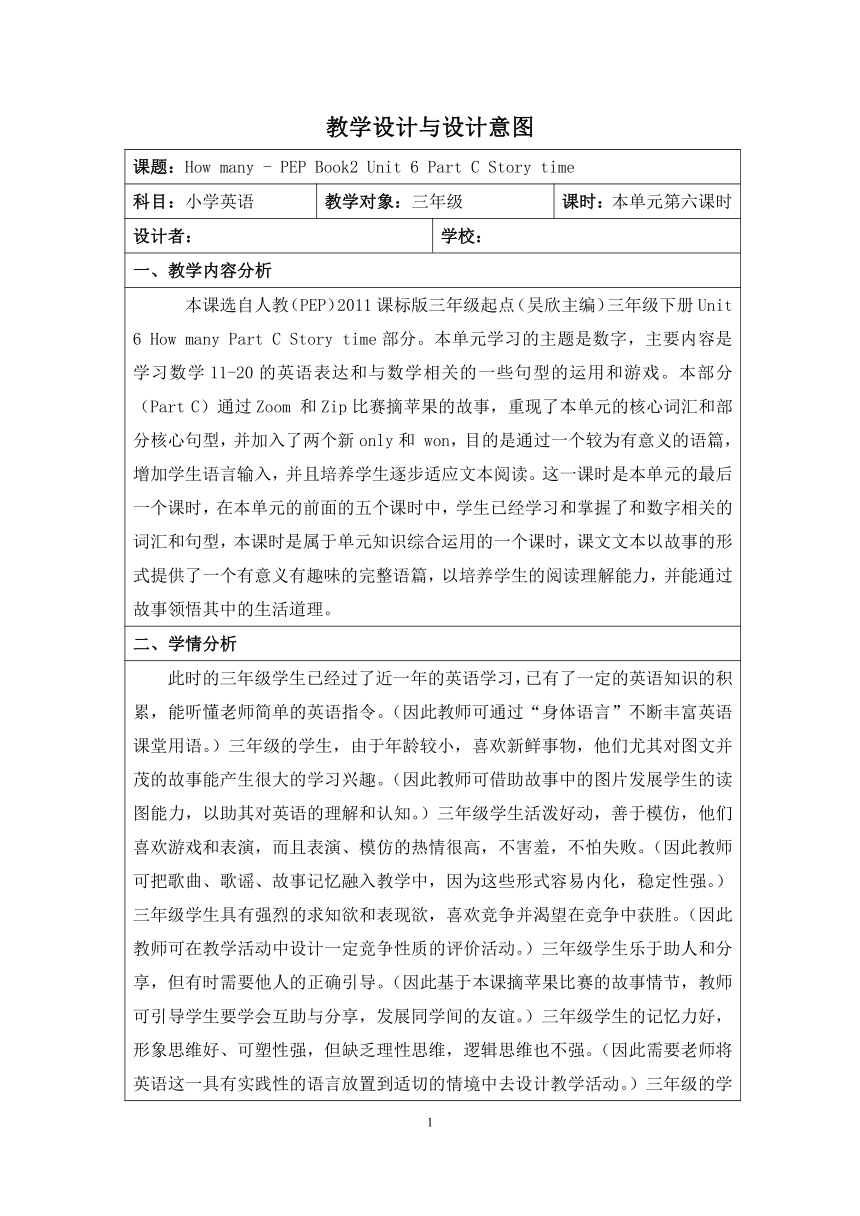 | |
| 格式 | zip | ||
| 文件大小 | 3.0MB | ||
| 资源类型 | 教案 | ||
| 版本资源 | 人教版(PEP) | ||
| 科目 | 英语 | ||
| 更新时间 | 2019-07-18 09:37:53 | ||
图片预览

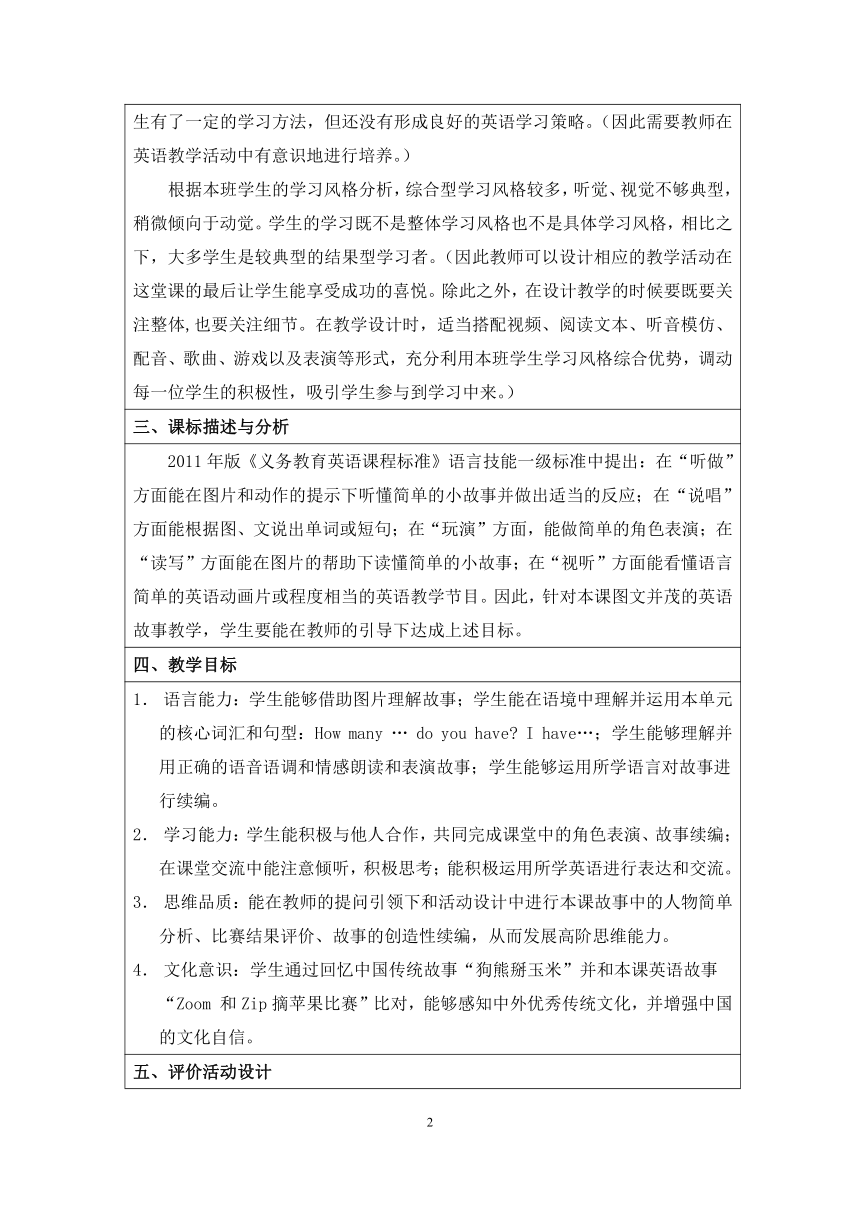
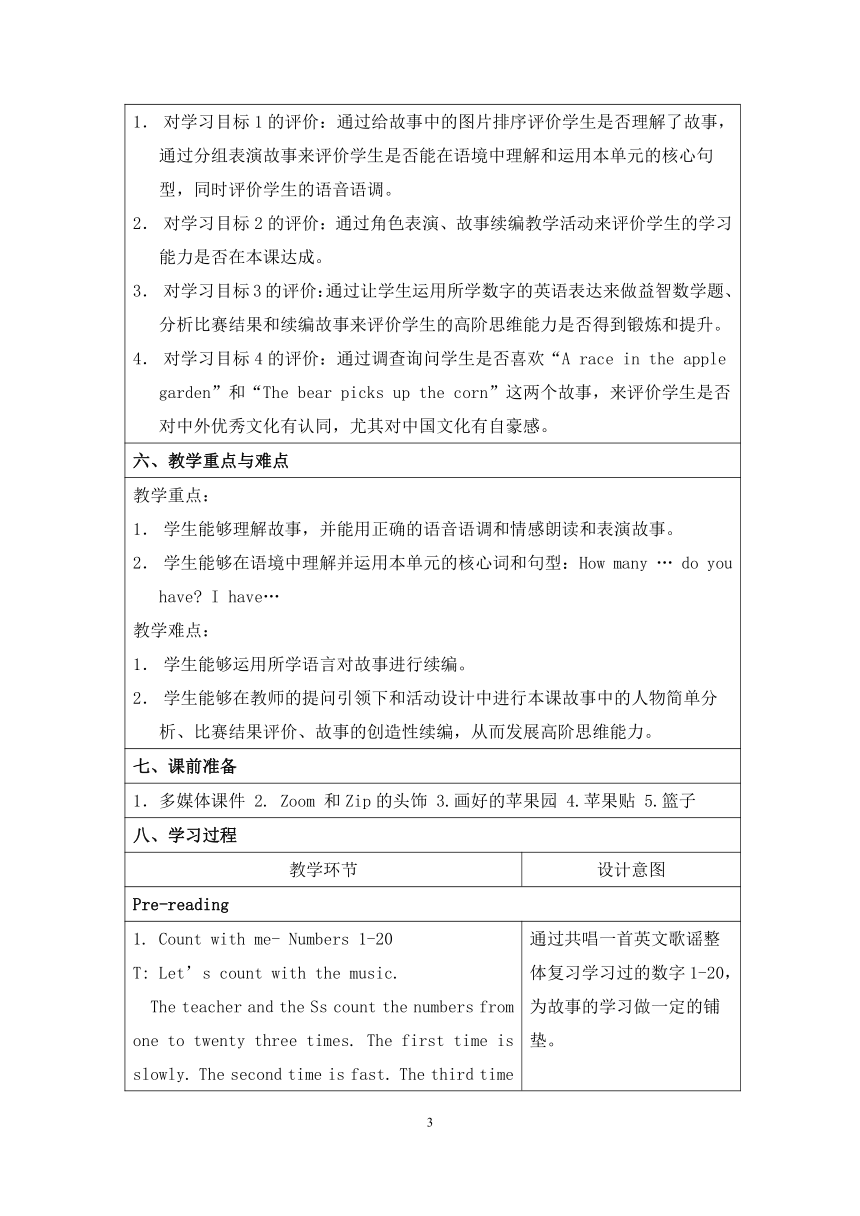
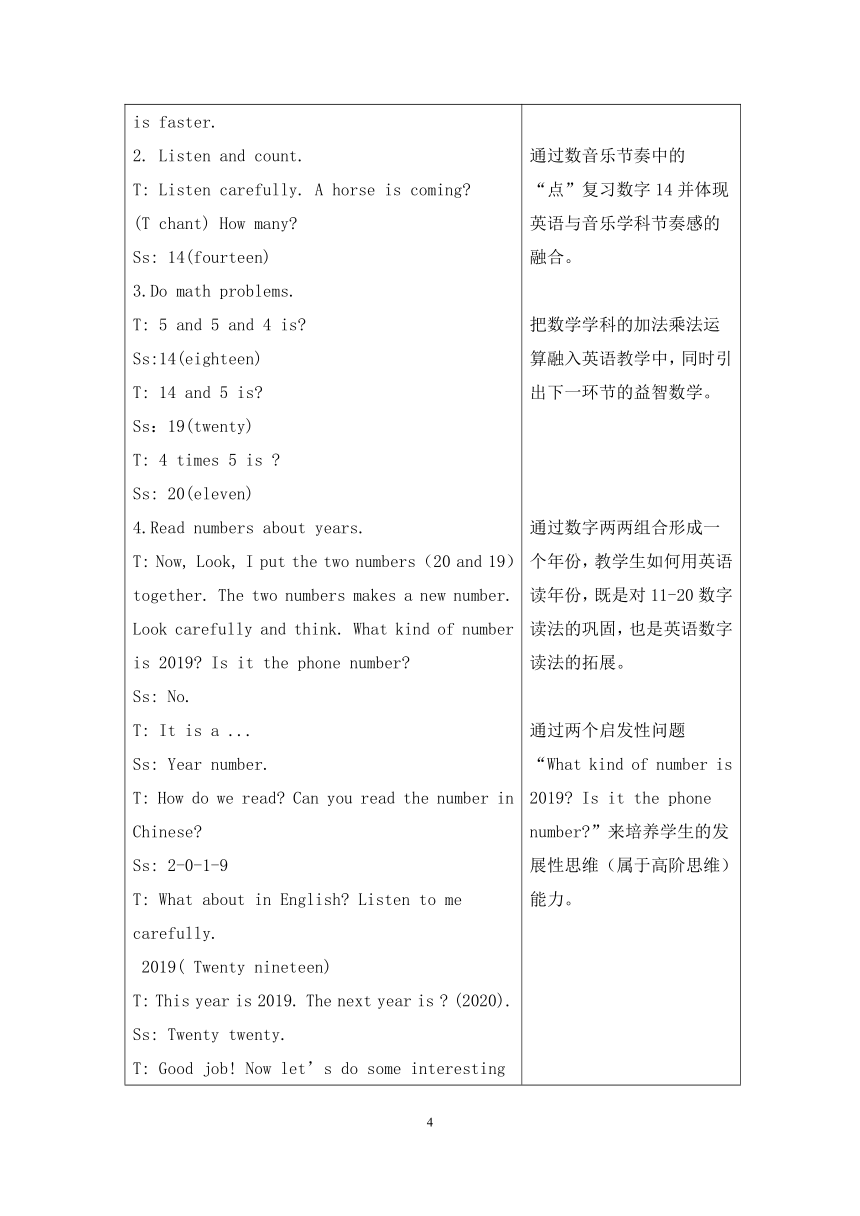
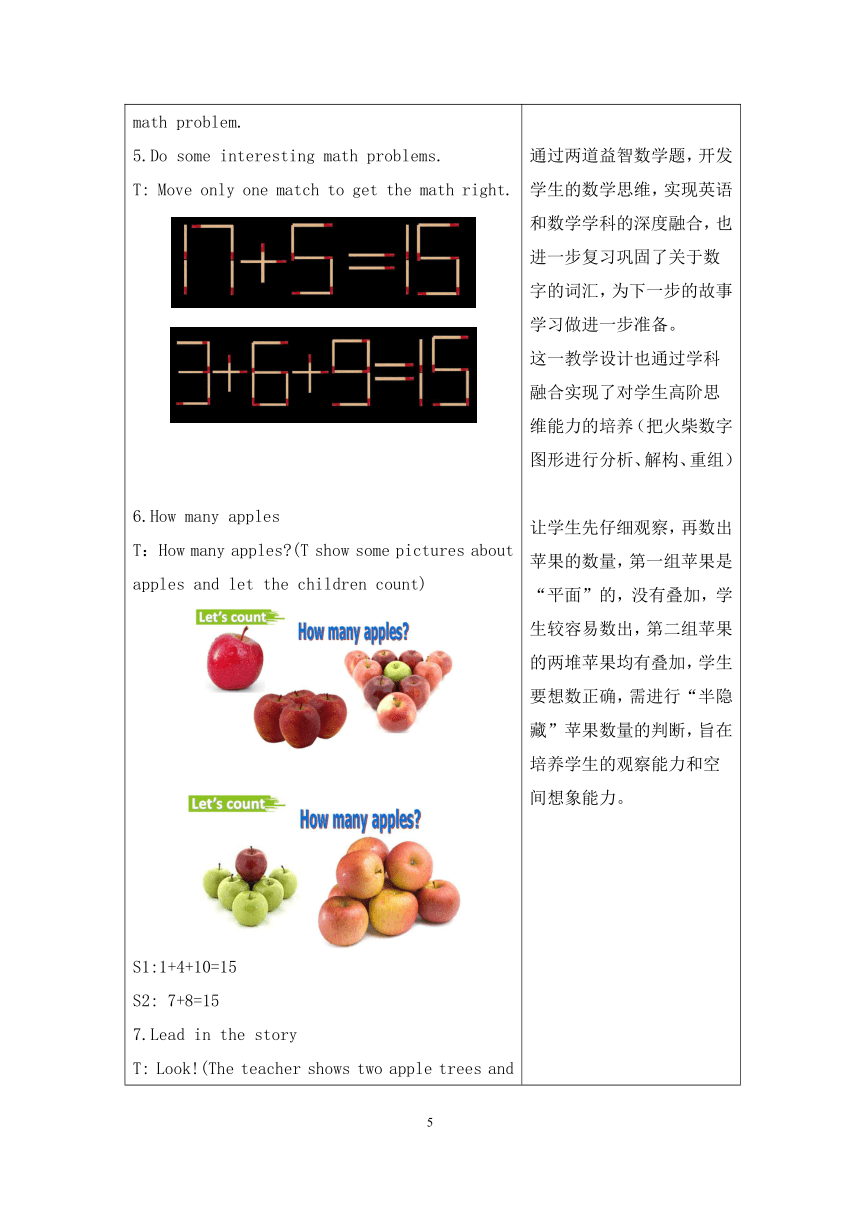
文档简介
教学设计与设计意图
课题:How many - PEP Book2 Unit 6 Part C Story time
科目:小学英语
教学对象:三年级
课时:本单元第六课时
设计者:
学校:
一、教学内容分析
本课选自人教(PEP)2011课标版三年级起点(吴欣主编)三年级下册Unit 6 How many Part C Story time部分。本单元学习的主题是数字,主要内容是学习数学11-20的英语表达和与数学相关的一些句型的运用和游戏。本部分(Part C)通过Zoom 和Zip比赛摘苹果的故事,重现了本单元的核心词汇和部分核心句型,并加入了两个新only和 won,目的是通过一个较为有意义的语篇,增加学生语言输入,并且培养学生逐步适应文本阅读。这一课时是本单元的最后一个课时,在本单元的前面的五个课时中,学生已经学习和掌握了和数字相关的词汇和句型,本课时是属于单元知识综合运用的一个课时,课文文本以故事的形式提供了一个有意义有趣味的完整语篇,以培养学生的阅读理解能力,并能通过故事领悟其中的生活道理。
二、学情分析
此时的三年级学生已经过了近一年的英语学习,已有了一定的英语知识的积累,能听懂老师简单的英语指令。(因此教师可通过“身体语言”不断丰富英语课堂用语。)三年级的学生,由于年龄较小,喜欢新鲜事物,他们尤其对图文并茂的故事能产生很大的学习兴趣。(因此教师可借助故事中的图片发展学生的读图能力,以助其对英语的理解和认知。)三年级学生活泼好动,善于模仿,他们喜欢游戏和表演,而且表演、模仿的热情很高,不害羞,不怕失败。(因此教师可把歌曲、歌谣、故事记忆融入教学中,因为这些形式容易内化,稳定性强。)三年级学生具有强烈的求知欲和表现欲,喜欢竞争并渴望在竞争中获胜。(因此教师可在教学活动中设计一定竞争性质的评价活动。)三年级学生乐于助人和分享,但有时需要他人的正确引导。(因此基于本课摘苹果比赛的故事情节,教师可引导学生要学会互助与分享,发展同学间的友谊。)三年级学生的记忆力好,形象思维好、可塑性强,但缺乏理性思维,逻辑思维也不强。(因此需要老师将英语这一具有实践性的语言放置到适切的情境中去设计教学活动。)三年级的学生有了一定的学习方法,但还没有形成良好的英语学习策略。(因此需要教师在英语教学活动中有意识地进行培养。)
根据本班学生的学习风格分析,综合型学习风格较多,听觉、视觉不够典型,稍微倾向于动觉。学生的学习既不是整体学习风格也不是具体学习风格,相比之下,大多学生是较典型的结果型学习者。(因此教师可以设计相应的教学活动在这堂课的最后让学生能享受成功的喜悦。除此之外,在设计教学的时候要既要关注整体,也要关注细节。在教学设计时,适当搭配视频、阅读文本、听音模仿、配音、歌曲、游戏以及表演等形式,充分利用本班学生学习风格综合优势,调动每一位学生的积极性,吸引学生参与到学习中来。)
三、课标描述与分析
2011年版《义务教育英语课程标准》语言技能一级标准中提出:在“听做”方面能在图片和动作的提示下听懂简单的小故事并做出适当的反应;在“说唱”方面能根据图、文说出单词或短句;在“玩演”方面,能做简单的角色表演;在“读写”方面能在图片的帮助下读懂简单的小故事;在“视听”方面能看懂语言简单的英语动画片或程度相当的英语教学节目。因此,针对本课图文并茂的英语故事教学,学生要能在教师的引导下达成上述目标。
四、教学目标
语言能力:学生能够借助图片理解故事;学生能在语境中理解并运用本单元的核心词汇和句型:How many … do you have? I have…;学生能够理解并用正确的语音语调和情感朗读和表演故事;学生能够运用所学语言对故事进行续编。
学习能力:学生能积极与他人合作,共同完成课堂中的角色表演、故事续编;在课堂交流中能注意倾听,积极思考;能积极运用所学英语进行表达和交流。
思维品质:能在教师的提问引领下和活动设计中进行本课故事中的人物简单分析、比赛结果评价、故事的创造性续编,从而发展高阶思维能力。
文化意识:学生通过回忆中国传统故事“狗熊掰玉米”并和本课英语故事“Zoom 和Zip摘苹果比赛”比对,能够感知中外优秀传统文化,并增强中国的文化自信。
五、评价活动设计
对学习目标1的评价:通过给故事中的图片排序评价学生是否理解了故事,通过分组表演故事来评价学生是否能在语境中理解和运用本单元的核心句型,同时评价学生的语音语调。
对学习目标2的评价:通过角色表演、故事续编教学活动来评价学生的学习能力是否在本课达成。
对学习目标3的评价:通过让学生运用所学数字的英语表达来做益智数学题、分析比赛结果和续编故事来评价学生的高阶思维能力是否得到锻炼和提升。
对学习目标4的评价:通过调查询问学生是否喜欢“A race in the apple garden”和“The bear picks up the corn”这两个故事,来评价学生是否对中外优秀文化有认同,尤其对中国文化有自豪感。
六、教学重点与难点
教学重点:
学生能够理解故事,并能用正确的语音语调和情感朗读和表演故事。
学生能够在语境中理解并运用本单元的核心词和句型:How many … do you have? I have…
教学难点:
学生能够运用所学语言对故事进行续编。
学生能够在教师的提问引领下和活动设计中进行本课故事中的人物简单分析、比赛结果评价、故事的创造性续编,从而发展高阶思维能力。
七、课前准备
1.多媒体课件 2. Zoom 和Zip的头饰 3.画好的苹果园 4.苹果贴 5.篮子
八、学习过程
教学环节
设计意图
Pre-reading
Count with me- Numbers 1-20
T: Let’s count with the music.
The teacher and the Ss count the numbers from one to twenty three times. The first time is slowly. The second time is fast. The third time is faster.
Listen and count.
T: Listen carefully. A horse is coming?
(T chant) How many?
Ss: 14(fourteen)
3.Do math problems.
T: 5 and 5 and 4 is?
Ss:14(eighteen)
T: 14 and 5 is?
Ss:19(twenty)
T: 4 times 5 is ?
Ss: 20(eleven)
4.Read numbers about years.
T: Now, Look, I put the two numbers(20 and 19) together. The two numbers makes a new number. Look carefully and think. What kind of number is 2019? Is it the phone number?
Ss: No.
T: It is a ...
Ss: Year number.
T: How do we read? Can you read the number in Chinese?
Ss: 2-0-1-9
T: What about in English? Listen to me carefully.
2019( Twenty nineteen)
T: This year is 2019. The next year is ? (2020).
Ss: Twenty twenty.
T: Good job! Now let’s do some interesting math problem.
5.Do some interesting math problems.
T: Move only one match to get the math right.
6.How many apples
T:How many apples?(T show some pictures about apples and let the children count)
S1:1+4+10=15
S2: 7+8=15
7.Lead in the story
T: Look!(The teacher shows two apple trees and say)
Ss: Wow! So many apples.(The teacher teaches the children how to read better.)
T: Look at the garden. What garden is it?(T point to the two apple trees on the blackboard and ask.)
Ss: It’s an apple garden.
通过共唱一首英文歌谣整体复习学习过的数字1-20,为故事的学习做一定的铺垫。
通过数音乐节奏中的“点”复习数字14并体现英语与音乐学科节奏感的融合。
把数学学科的加法乘法运算融入英语教学中,同时引出下一环节的益智数学。
通过数字两两组合形成一个年份,教学生如何用英语读年份,既是对11-20数字读法的巩固,也是英语数字读法的拓展。
通过两个启发性问题“What kind of number is 2019? Is it the phone number?”来培养学生的发展性思维(属于高阶思维)能力。
通过两道益智数学题,开发学生的数学思维,实现英语和数学学科的深度融合,也进一步复习巩固了关于数字的词汇,为下一步的故事学习做进一步准备。
这一教学设计也通过学科融合实现了对学生高阶思维能力的培养(把火柴数字图形进行分析、解构、重组)
让学生先仔细观察,再数出苹果的数量,第一组苹果是“平面”的,没有叠加,学生较容易数出,第二组苹果的两堆苹果均有叠加,学生要想数正确,需进行“半隐藏”苹果数量的判断,旨在培养学生的观察能力和空间想象能力。
通过出示挂满苹果的苹果树让学生感知并理解语言“Wow! So many apples.
In-reading
Guess and watch the video.
T: Guess who is in the garden ?
S1: Zoom and Zip.
T: Guess What they will do next?
S1: Pick up the apples.
S2: Eat apples.
S3: Make an apple pie.
S4: Have a race.
Practice the following sentences.
“Wow! So many apples! Let’s have a race.”
“Good idea!”
T: Guess who will win.
S1: Zoom
T: Who do you think Zoom will win?
S1: Zoom is strong.
S2: Zip.
T: Why?
S2: Zip is clever. Zip can climb the tree.
T:Please watch the story and then tell us who won.
Ss: Zip won.
2. Read and match
T: Please watch the story and match.
Practice reading better
T: Zip got 17 apples, so Zip is very happy. He said to Zoom:
Ss: Look, I have 17! How many apples do you have?(How do we read happier? (T teach the children how to read better.)
T: How does Zoom answer?
Ss: Oh, no! I have only three.
T: Zoom has only three apples. He is not happy. He is sad. So he said sadly.(The teacher gives a model reading) Who can read better?
S:….
4.Number the pictures
T: Now, look at the pictures about the story. But their orders are not right. Can you number the pictures? Please try.(The Ss number the pictures on the learning list.)
When the Ss finished. The teacher takes photos of the children’s learning list. Then the teacher uses the interactive system to display the photos on the big screen.
Listen and imitate
T: Watch the video and imitate. Pay more attention to your pronunciation and intonation.
通过让学生猜测Zoom 和Zip将要发生什么来预测故事的开头。
通过引导学生读关键句子让学生体会如何用语气表达惊奇、惊喜。
通过让学生思考并回答猜测Zoom或Zip获胜的理由,来培养学生高阶思维能力
阅读能力和技巧应该从英语起始年级就开始渗透和训练,此设计旨在通过问题引领培养训练学生获取文本大意的阅读能力。
通过连线的方法使学生理解故事的细节。
通过引导学生读关键句子让学生体会如何不用的语气表达不同的情感,并在读中理解only和won的意思。
通过给图片排序让学生进一步加深故事发生的顺序。
教师首先把学生在评测练习单上的标号情况拍照,然后通过“易课”互动系统即时显示在大屏幕上,用以核对学生标号情况。实现信息技术与英语教学的融合。
通过让学生模仿语音语调以形成地道的口语。
Post-reading
Read in roles.
T: Let’s read the story in roles. Boys act as Zoom. Girls act as Zip.
Voice the story
T: No sound in the video. Can you voice the story? Practice in pairs.
T:Which pairs want to try?
3. Act out the story in groups.
T: Now we are in the apple garden. Let’s have a race. Please try to act out the story in groups.
T: Which group wants to try?(The teacher finds some groups to come to the front and perform.
4.Emotional education
T: Why did Zoom lost the race?
S: Zoom has no baskets
T: Yes. Basket is a kind of tool. Tools are very useful in our life.
5.Continue the story in groups.
T:In this story, Zip won. Zoom lost the race. What will happen next? Can you continue the story. Please discuss in groups first, and then try to perform.
When the Ss finished, the teacher find several groups to come to the front and perform the story they continued.
6.Watch the mini-video about “The bear picks up the corn”
T: In China, we have a famous story about the bear. Let’s watch the video.
The teacher play the video and voice the story.
T: Do you like the story?
Ss: Yes.
T: What did you learn from the story?
S1: Use our heart.
T: Yes. Doing by heart.
T: Learn the new but never forget the old.
The teacher and the Ss read the two sentences together.
分角色朗读为下一步的表演故事做准备。
让学生练习给英语视频配音能激发学生兴趣,培养语音模仿意识和能力。
分组练习表演旨在通过表演让这个故事鲜活起来,同时培养学生合作品质和合作能力。
学生分组轮流上台表演能培养学生的表演自信。
通过让学生分析比赛结果来培养学生高阶思维能力。
通过续编故事培养学生的创造性思维(属于高阶思维)能力。
通过让学生分组表演展示自己小组续编的故事来培养学生的语言运用能力。
通过中外优秀儿童故事对比让学生感受中外优秀文化,并在潜意识中增强对中国文化的认同。
通过启发学生思考从故事中所得来培养学生用心做事的良好习惯和品质。
Homework
Listen to the story and imitate.
Tell the story to your friend.
Blackboard writing
课题:How many - PEP Book2 Unit 6 Part C Story time
科目:小学英语
教学对象:三年级
课时:本单元第六课时
设计者:
学校:
一、教学内容分析
本课选自人教(PEP)2011课标版三年级起点(吴欣主编)三年级下册Unit 6 How many Part C Story time部分。本单元学习的主题是数字,主要内容是学习数学11-20的英语表达和与数学相关的一些句型的运用和游戏。本部分(Part C)通过Zoom 和Zip比赛摘苹果的故事,重现了本单元的核心词汇和部分核心句型,并加入了两个新only和 won,目的是通过一个较为有意义的语篇,增加学生语言输入,并且培养学生逐步适应文本阅读。这一课时是本单元的最后一个课时,在本单元的前面的五个课时中,学生已经学习和掌握了和数字相关的词汇和句型,本课时是属于单元知识综合运用的一个课时,课文文本以故事的形式提供了一个有意义有趣味的完整语篇,以培养学生的阅读理解能力,并能通过故事领悟其中的生活道理。
二、学情分析
此时的三年级学生已经过了近一年的英语学习,已有了一定的英语知识的积累,能听懂老师简单的英语指令。(因此教师可通过“身体语言”不断丰富英语课堂用语。)三年级的学生,由于年龄较小,喜欢新鲜事物,他们尤其对图文并茂的故事能产生很大的学习兴趣。(因此教师可借助故事中的图片发展学生的读图能力,以助其对英语的理解和认知。)三年级学生活泼好动,善于模仿,他们喜欢游戏和表演,而且表演、模仿的热情很高,不害羞,不怕失败。(因此教师可把歌曲、歌谣、故事记忆融入教学中,因为这些形式容易内化,稳定性强。)三年级学生具有强烈的求知欲和表现欲,喜欢竞争并渴望在竞争中获胜。(因此教师可在教学活动中设计一定竞争性质的评价活动。)三年级学生乐于助人和分享,但有时需要他人的正确引导。(因此基于本课摘苹果比赛的故事情节,教师可引导学生要学会互助与分享,发展同学间的友谊。)三年级学生的记忆力好,形象思维好、可塑性强,但缺乏理性思维,逻辑思维也不强。(因此需要老师将英语这一具有实践性的语言放置到适切的情境中去设计教学活动。)三年级的学生有了一定的学习方法,但还没有形成良好的英语学习策略。(因此需要教师在英语教学活动中有意识地进行培养。)
根据本班学生的学习风格分析,综合型学习风格较多,听觉、视觉不够典型,稍微倾向于动觉。学生的学习既不是整体学习风格也不是具体学习风格,相比之下,大多学生是较典型的结果型学习者。(因此教师可以设计相应的教学活动在这堂课的最后让学生能享受成功的喜悦。除此之外,在设计教学的时候要既要关注整体,也要关注细节。在教学设计时,适当搭配视频、阅读文本、听音模仿、配音、歌曲、游戏以及表演等形式,充分利用本班学生学习风格综合优势,调动每一位学生的积极性,吸引学生参与到学习中来。)
三、课标描述与分析
2011年版《义务教育英语课程标准》语言技能一级标准中提出:在“听做”方面能在图片和动作的提示下听懂简单的小故事并做出适当的反应;在“说唱”方面能根据图、文说出单词或短句;在“玩演”方面,能做简单的角色表演;在“读写”方面能在图片的帮助下读懂简单的小故事;在“视听”方面能看懂语言简单的英语动画片或程度相当的英语教学节目。因此,针对本课图文并茂的英语故事教学,学生要能在教师的引导下达成上述目标。
四、教学目标
语言能力:学生能够借助图片理解故事;学生能在语境中理解并运用本单元的核心词汇和句型:How many … do you have? I have…;学生能够理解并用正确的语音语调和情感朗读和表演故事;学生能够运用所学语言对故事进行续编。
学习能力:学生能积极与他人合作,共同完成课堂中的角色表演、故事续编;在课堂交流中能注意倾听,积极思考;能积极运用所学英语进行表达和交流。
思维品质:能在教师的提问引领下和活动设计中进行本课故事中的人物简单分析、比赛结果评价、故事的创造性续编,从而发展高阶思维能力。
文化意识:学生通过回忆中国传统故事“狗熊掰玉米”并和本课英语故事“Zoom 和Zip摘苹果比赛”比对,能够感知中外优秀传统文化,并增强中国的文化自信。
五、评价活动设计
对学习目标1的评价:通过给故事中的图片排序评价学生是否理解了故事,通过分组表演故事来评价学生是否能在语境中理解和运用本单元的核心句型,同时评价学生的语音语调。
对学习目标2的评价:通过角色表演、故事续编教学活动来评价学生的学习能力是否在本课达成。
对学习目标3的评价:通过让学生运用所学数字的英语表达来做益智数学题、分析比赛结果和续编故事来评价学生的高阶思维能力是否得到锻炼和提升。
对学习目标4的评价:通过调查询问学生是否喜欢“A race in the apple garden”和“The bear picks up the corn”这两个故事,来评价学生是否对中外优秀文化有认同,尤其对中国文化有自豪感。
六、教学重点与难点
教学重点:
学生能够理解故事,并能用正确的语音语调和情感朗读和表演故事。
学生能够在语境中理解并运用本单元的核心词和句型:How many … do you have? I have…
教学难点:
学生能够运用所学语言对故事进行续编。
学生能够在教师的提问引领下和活动设计中进行本课故事中的人物简单分析、比赛结果评价、故事的创造性续编,从而发展高阶思维能力。
七、课前准备
1.多媒体课件 2. Zoom 和Zip的头饰 3.画好的苹果园 4.苹果贴 5.篮子
八、学习过程
教学环节
设计意图
Pre-reading
Count with me- Numbers 1-20
T: Let’s count with the music.
The teacher and the Ss count the numbers from one to twenty three times. The first time is slowly. The second time is fast. The third time is faster.
Listen and count.
T: Listen carefully. A horse is coming?
(T chant) How many?
Ss: 14(fourteen)
3.Do math problems.
T: 5 and 5 and 4 is?
Ss:14(eighteen)
T: 14 and 5 is?
Ss:19(twenty)
T: 4 times 5 is ?
Ss: 20(eleven)
4.Read numbers about years.
T: Now, Look, I put the two numbers(20 and 19) together. The two numbers makes a new number. Look carefully and think. What kind of number is 2019? Is it the phone number?
Ss: No.
T: It is a ...
Ss: Year number.
T: How do we read? Can you read the number in Chinese?
Ss: 2-0-1-9
T: What about in English? Listen to me carefully.
2019( Twenty nineteen)
T: This year is 2019. The next year is ? (2020).
Ss: Twenty twenty.
T: Good job! Now let’s do some interesting math problem.
5.Do some interesting math problems.
T: Move only one match to get the math right.
6.How many apples
T:How many apples?(T show some pictures about apples and let the children count)
S1:1+4+10=15
S2: 7+8=15
7.Lead in the story
T: Look!(The teacher shows two apple trees and say)
Ss: Wow! So many apples.(The teacher teaches the children how to read better.)
T: Look at the garden. What garden is it?(T point to the two apple trees on the blackboard and ask.)
Ss: It’s an apple garden.
通过共唱一首英文歌谣整体复习学习过的数字1-20,为故事的学习做一定的铺垫。
通过数音乐节奏中的“点”复习数字14并体现英语与音乐学科节奏感的融合。
把数学学科的加法乘法运算融入英语教学中,同时引出下一环节的益智数学。
通过数字两两组合形成一个年份,教学生如何用英语读年份,既是对11-20数字读法的巩固,也是英语数字读法的拓展。
通过两个启发性问题“What kind of number is 2019? Is it the phone number?”来培养学生的发展性思维(属于高阶思维)能力。
通过两道益智数学题,开发学生的数学思维,实现英语和数学学科的深度融合,也进一步复习巩固了关于数字的词汇,为下一步的故事学习做进一步准备。
这一教学设计也通过学科融合实现了对学生高阶思维能力的培养(把火柴数字图形进行分析、解构、重组)
让学生先仔细观察,再数出苹果的数量,第一组苹果是“平面”的,没有叠加,学生较容易数出,第二组苹果的两堆苹果均有叠加,学生要想数正确,需进行“半隐藏”苹果数量的判断,旨在培养学生的观察能力和空间想象能力。
通过出示挂满苹果的苹果树让学生感知并理解语言“Wow! So many apples.
In-reading
Guess and watch the video.
T: Guess who is in the garden ?
S1: Zoom and Zip.
T: Guess What they will do next?
S1: Pick up the apples.
S2: Eat apples.
S3: Make an apple pie.
S4: Have a race.
Practice the following sentences.
“Wow! So many apples! Let’s have a race.”
“Good idea!”
T: Guess who will win.
S1: Zoom
T: Who do you think Zoom will win?
S1: Zoom is strong.
S2: Zip.
T: Why?
S2: Zip is clever. Zip can climb the tree.
T:Please watch the story and then tell us who won.
Ss: Zip won.
2. Read and match
T: Please watch the story and match.
Practice reading better
T: Zip got 17 apples, so Zip is very happy. He said to Zoom:
Ss: Look, I have 17! How many apples do you have?(How do we read happier? (T teach the children how to read better.)
T: How does Zoom answer?
Ss: Oh, no! I have only three.
T: Zoom has only three apples. He is not happy. He is sad. So he said sadly.(The teacher gives a model reading) Who can read better?
S:….
4.Number the pictures
T: Now, look at the pictures about the story. But their orders are not right. Can you number the pictures? Please try.(The Ss number the pictures on the learning list.)
When the Ss finished. The teacher takes photos of the children’s learning list. Then the teacher uses the interactive system to display the photos on the big screen.
Listen and imitate
T: Watch the video and imitate. Pay more attention to your pronunciation and intonation.
通过让学生猜测Zoom 和Zip将要发生什么来预测故事的开头。
通过引导学生读关键句子让学生体会如何用语气表达惊奇、惊喜。
通过让学生思考并回答猜测Zoom或Zip获胜的理由,来培养学生高阶思维能力
阅读能力和技巧应该从英语起始年级就开始渗透和训练,此设计旨在通过问题引领培养训练学生获取文本大意的阅读能力。
通过连线的方法使学生理解故事的细节。
通过引导学生读关键句子让学生体会如何不用的语气表达不同的情感,并在读中理解only和won的意思。
通过给图片排序让学生进一步加深故事发生的顺序。
教师首先把学生在评测练习单上的标号情况拍照,然后通过“易课”互动系统即时显示在大屏幕上,用以核对学生标号情况。实现信息技术与英语教学的融合。
通过让学生模仿语音语调以形成地道的口语。
Post-reading
Read in roles.
T: Let’s read the story in roles. Boys act as Zoom. Girls act as Zip.
Voice the story
T: No sound in the video. Can you voice the story? Practice in pairs.
T:Which pairs want to try?
3. Act out the story in groups.
T: Now we are in the apple garden. Let’s have a race. Please try to act out the story in groups.
T: Which group wants to try?(The teacher finds some groups to come to the front and perform.
4.Emotional education
T: Why did Zoom lost the race?
S: Zoom has no baskets
T: Yes. Basket is a kind of tool. Tools are very useful in our life.
5.Continue the story in groups.
T:In this story, Zip won. Zoom lost the race. What will happen next? Can you continue the story. Please discuss in groups first, and then try to perform.
When the Ss finished, the teacher find several groups to come to the front and perform the story they continued.
6.Watch the mini-video about “The bear picks up the corn”
T: In China, we have a famous story about the bear. Let’s watch the video.
The teacher play the video and voice the story.
T: Do you like the story?
Ss: Yes.
T: What did you learn from the story?
S1: Use our heart.
T: Yes. Doing by heart.
T: Learn the new but never forget the old.
The teacher and the Ss read the two sentences together.
分角色朗读为下一步的表演故事做准备。
让学生练习给英语视频配音能激发学生兴趣,培养语音模仿意识和能力。
分组练习表演旨在通过表演让这个故事鲜活起来,同时培养学生合作品质和合作能力。
学生分组轮流上台表演能培养学生的表演自信。
通过让学生分析比赛结果来培养学生高阶思维能力。
通过续编故事培养学生的创造性思维(属于高阶思维)能力。
通过让学生分组表演展示自己小组续编的故事来培养学生的语言运用能力。
通过中外优秀儿童故事对比让学生感受中外优秀文化,并在潜意识中增强对中国文化的认同。
通过启发学生思考从故事中所得来培养学生用心做事的良好习惯和品质。
Homework
Listen to the story and imitate.
Tell the story to your friend.
Blackboard writing
